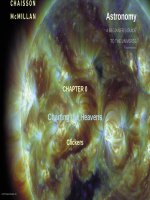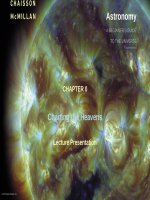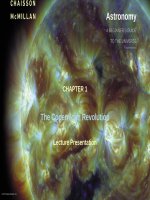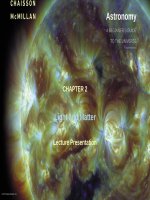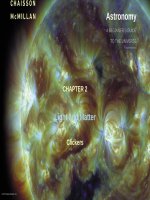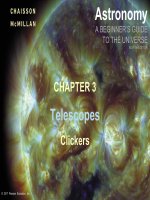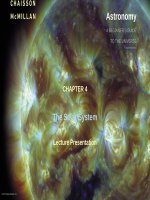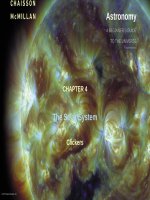Astronomy a beginners guide to the universe 8th CHaisson mcmillan chapter 01 clicker questions
Bạn đang xem bản rút gọn của tài liệu. Xem và tải ngay bản đầy đủ của tài liệu tại đây (1.29 MB, 29 trang )
Astronomy
A BEGINNER’S GUIDE
TO THE UNIVERSE
EIGHTH EDITION
CHAPTER 1
The Copernican Revolution
Clickers
© 2017 Pearson Education, Inc.
Question 1
Mars, Jupiter, and Saturn show retrograde motion because
a)
b)
planets move on epicycles.
planets orbit the Sun in the
same direction.
c)
d)
e)
© 2017 Pearson Education, Inc.
Earth moves faster in its orbit.
they are closer than Uranus.
they rotate quickly on their axes.
Question 1
Mars, Jupiter, and Saturn show retrograde motion because
a)
b)
planets move on epicycles.
planets orbit the Sun in the
same direction.
c)
d)
e)
Earth moves faster in its orbit.
they are closer than Uranus.
they rotate quickly on their axes.
Explanation: As Earth overtakes and
“passes” the outer planets, they seem
to slow down and then reverse direction.
© 2017 Pearson Education, Inc.
Question 2
How did the geocentric model account for day and night on Earth?
a)
b)
c)
The Earth rotated.
The Sun rotated.
The geocentric model couldn’t
account for day and night.
d)
e)
© 2017 Pearson Education, Inc.
The Earth revolved around the Sun.
The Sun orbited Earth.
Question 2
How did the geocentric model account for day and night on Earth?
a)
b)
c)
The Earth rotated.
The Sun rotated.
The geocentric model couldn’t
account for day and night.
d)
e)
The Earth revolved around the Sun.
The Sun orbited Earth.
Explanation: The geocentric model
held that the Earth was motionless in
the center of the universe.
© 2017 Pearson Education, Inc.
Question 3
Epicycles were used in Ptolemy’s model to explain why
a)
b)
c)
d)
e)
planets moved in the sky.
Earth was at the center.
retrograde motion occurred.
Earth wobbled on its axis.
inner planets were always
seen near the Sun.
© 2017 Pearson Education, Inc.
Question 3
Epicycles were used in Ptolemy’s model to explain why
a)
b)
c)
d)
e)
planets moved in the sky.
Earth was at the center.
retrograde motion occurred.
Earth wobbled on its axis.
inner planets were always
seen near the Sun.
Explanation: Planets were assumed
to move uniformly on an epicycle,
as it moved uniformly around Earth.
© 2017 Pearson Education, Inc.
Question 4
The geocentric model was supported by Aristotle because of which of the following?
a)
b)
c)
d)
e)
© 2017 Pearson Education, Inc.
Stars don’t seem to show any parallax.
We don’t feel as though Earth moves.
Objects fall toward Earth, not the Sun.
We don’t see an enormous wind.
All of the above were valid reasons.
Question 4
The geocentric model was supported by Aristotle because of which of the following?
a)
b)
c)
d)
e)
Stars don’t seem to show any parallax.
We don’t feel as though Earth moves.
Objects fall toward Earth, not the Sun.
We don’t see an enormous wind.
All of the above were valid reasons.
Explanation: Aristotle thought that if the Earth
rotated and orbited, we would feel its motion.
In Aristotle’s time, the size of the solar system
and distances to stars were assumed to be much,
much smaller. Parallax was expected to be seen.
© 2017 Pearson Education, Inc.
Question 5
The heliocentric model assumes that
a)
b)
c)
d)
e)
© 2017 Pearson Education, Inc.
planets move on epicycles.
Earth is the center of the solar system.
the stars move on the celestial sphere.
the Sun is the center of the solar system.
Earth’s axis wobbles over 26,000 years.
Question 5
The heliocentric model assumes that
a)
b)
c)
d)
e)
planets move on epicycles.
Earth is the center of the solar system.
the stars move on the celestial sphere.
the Sun is the center of the solar system.
Earth’s axis wobbles over 26,000 years.
Explanation: Heliocentric models
proposed by Aristarchus and others
were considered wrong by Aristotle
and his followers.
© 2017 Pearson Education, Inc.
Question 6
Copernicus’s important contribution to astronomy was
a)
b)
c)
d)
proving planets move around the Sun in elliptical orbits.
the theory of gravity.
proposing a model that easily explained the retrograde motions of the planets.
discovering the Sun was not at the
center of the Milky Way.
e)
© 2017 Pearson Education, Inc.
discovering the four moons of Jupiter.
Question 6
Copernicus’s important contribution to astronomy was
a)
b)
c)
d)
proving planets move around the Sun in elliptical orbits.
the theory of gravity.
proposing a model that easily explained the retrograde motions of the planets.
discovering the Sun was not at the
center of the Milky Way.
e)
discovering the four moons of Jupiter.
Explanation: His heliocentric model easily
explained retrograde motion because
planets orbited the Sun at different speeds.
© 2017 Pearson Education, Inc.
Question 7
Copernicus’s heliocentric model was flawed because he
a)
b)
c)
d)
e)
assumed planets moved in ellipses.
didn’t know about Uranus and Neptune.
couldn’t account for gravity.
couldn’t explain retrograde motion.
didn’t assume planets moved
in ellipses.
© 2017 Pearson Education, Inc.
Question 7
Copernicus’s heliocentric model was flawed because he
a)
b)
c)
d)
e)
assumed planets moved in ellipses.
didn’t know about Uranus and Neptune.
couldn’t account for gravity.
couldn’t explain retrograde motion.
didn’t assume planets moved
in ellipses.
Explanation: Copernicus’s model still
needed small epicycles to account for
observed changes in planetary speeds.
© 2017 Pearson Education, Inc.
Question 8
Who published the first astronomical observations made with a telescope?
a)
b)
c)
d)
e)
© 2017 Pearson Education, Inc.
Hipparchus
Galileo
Tycho
Copernicus
Kepler
Question 8
Who published the first astronomical observations made with a telescope?
a)
b)
c)
d)
e)
Hipparchus
Galileo
Tycho
Copernicus
Kepler
Explanation: Galileo published the “Starry Messenger” in 1610, detailing his observations of the Moon, Jupiter’s
moons, stars, and nebulae.
© 2017 Pearson Education, Inc.
Question 9
Which of Galileo’s initial observations was most challenging to established geocentric beliefs?
a)
b)
c)
d)
e)
© 2017 Pearson Education, Inc.
Craters on the Moon
Sunspots
Lunar maria
Satellites of Jupiter
Stars of the Milky Way
Question 9
Which of Galileo’s initial observations was most challenging to established geocentric beliefs?
a)
b)
c)
d)
e)
Craters on the Moon
Sunspots
Lunar maria
Satellites of Jupiter
Stars of the Milky Way
Explanation: Seeing four moons clearly
move around Jupiter disproved that
everything orbited Earth and showed
Earth could orbit the Sun and not lose its
moon, too.
© 2017 Pearson Education, Inc.
Question 10
Which hero of the Renaissance postulated three “laws” of planetary motion?
a)
b)
c)
d)
e)
© 2017 Pearson Education, Inc.
Kepler
Newton
Galileo
Tycho Brahe
Copernicus
Question 10
Which hero of the Renaissance postulated three “laws” of planetary motion?
a)
b)
c)
d)
e)
Kepler
Newton
Galileo
Tycho Brahe
Copernicus
Explanation: Note that Isaac Newton is also well known for three general laws of motion, but Kepler’s laws are about
objects in orbits, like planets orbiting a star.
© 2017 Pearson Education, Inc.
Question 11
Kepler’s first law of planetary orbits states that
a)
b)
c)
d)
© 2017 Pearson Education, Inc.
planets orbit the Sun.
orbits are noncircular.
orbits are elliptical in shape.
all of the above are stated.
Question 11
Kepler’s first law of planetary orbits states that
a)
b)
c)
d)
planets orbit the Sun.
orbits are noncircular.
orbits are elliptical in shape.
all of the above are stated.
Explanation: Kepler’s laws apply
to all orbiting objects. The Moon
orbits Earth in an ellipse, and the
Space Shuttle orbits Earth in an
ellipse, too.
© 2017 Pearson Education, Inc.
Question 12
Earth is closer to the Sun in January. From this fact, Kepler’s second law tells us that
a)
b)
c)
© 2017 Pearson Education, Inc.
Earth orbits slower in January.
Earth orbits faster in January.
Earth’s orbital speed doesn’t change.
Question 12
Earth is closer to the Sun in January. From this fact, Kepler’s second law tells us
a)
b)
c)
Earth orbits slower in January.
Earth orbits faster in January.
Earth’s orbital speed doesn’t change.
Explanation: Kepler’s second law
means that a planet moves
faster when closer to its star.
© 2017 Pearson Education, Inc.
